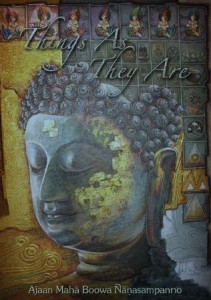
Things as they are are talks initially given to the monks at Acariya Maha Boowa’s monastery, Wat Pa Baan Taad, in Udorn Thani Province, Thailand. As might be expected, they deal in part with issues particular to the life of Buddhist monks, but they also contain much that is of more general interest. Since the monks assembled to listen to these talks were at different stages in their practice, each talk dealt with several issues on various levels. Thus, there should be something of use in these pages for every reader interested in the training of the citta. Download it here (224 pages):
 Things As They Are
Things As They Are
You can buy the print version here: Link
What is Citta in Buddhism?
“Citta” is a term in Buddhism that is often translated as “mind” or “consciousness.” However, its meaning is multifaceted and can vary depending on the context in which it is used.
Here are some key points about “citta” in Buddhism:
- Basic Meaning: At its most basic level, “citta” refers to the mind as the seat of consciousness, encompassing both cognitive and emotional aspects.
- Three Aspects of Existence: In the Theravāda Abhidhamma (a systematic analysis of the Buddha’s teachings), all experiences are analyzed in terms of three aspects: citta (consciousness), cetasika (mental factors), and rūpa (material form). Here, “citta” is the knowing aspect of the mind, while “cetasika” are the various mental factors that arise and cease with consciousness.
- Types of Citta: The Abhidhamma classifies citta into different types based on various criteria, such as the object of consciousness, the quality of the consciousness (wholesome, unwholesome, or neutral), and the plane of existence in which it arises.
- Citta as a Stream: In many Buddhist texts, the continuity of consciousness is described as a stream (santāna), often referred to as the “stream of consciousness.” This stream flows on from one life to the next, playing a central role in the process of rebirth.
- Citta in Meditation: In the context of meditation, understanding the nature of “citta” is crucial. Meditators are often instructed to observe the arising and passing away of citta and its associated mental factors to gain insight into the impermanent, unsatisfactory, and non-self nature of existence.
- Citta-viṭṭi: This term refers to the “thought processes” or “modes of consciousness.” In meditation, one might observe different citta-viṭṭi as the mind reacts to various stimuli or gets absorbed in different states.
- Purification of Citta: One of the goals of Buddhist practice is the purification of the mind. This involves removing defilements (kilesas) such as greed, hatred, and delusion, leading to a state of clarity, peace, and eventually, enlightenment.
It’s worth noting that the interpretation and emphasis on “citta” can vary between different Buddhist traditions. While the above points are largely based on the Theravāda tradition, other Buddhist schools, such as the Mahāyāna and Vajrayāna traditions, might have slightly different perspectives and teachings on the concept.

